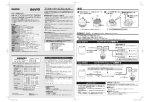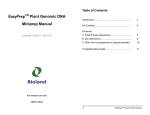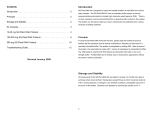Download E.Z.N.A.®SP Plant DNA Maxi Kit - Omega Bio-Tek
Transcript
E.Z.N.A.® SP Plant DNA Maxi Kit D5538-00 D5538-01 2 preps 5 preps February 2014 E.Z.N.A.® SP Plant DNA Maxi Kit Table of Contents Introduction and Overview.......................................................2 Kit Contents/Storage and Stability.........................................3 Preparing Reagents.......................................................................4 Sample Preparation......................................................................5 SP Plant DNA Maxi Protocol - Dried Samples......................6 SP Plant DNA Maxi Protocol - Fresh/Frozen Samples.....10 Troubleshooting Guide.............................................................14 Ordering....................................................................................15 Manual Revision: February 2014 Innovations in nucleic acid isolation 1 Introduction and Overview The E.Z.N.A.® SP Plant DNA Maxi Kit is specially designed for rapid and reliable isolation of high-quality total cellular DNA from plant species containing high levels of phenolic compounds and polysaccharides. Up to 1 g wet tissue (or 250 mg dry tissue) can be processed in less than 1 hour. The system combines the reversible nucleic acid-binding properties of the HiBind® matrix with the speed and versatility of spin column technology to eliminate polysaccharides, phenolic compounds, and enzyme inhibitors from plant tissue lysates. Purified DNA is suitable for PCR, restriction digestion, and hybridization techniques. If using the E.Z.N.A.® SP Plant DNA Maxi Kit for the first time, please read this booklet to become familiar with the procedures. Dry or fresh/frozen plant tissue is disrupted and lysed in a specially formulated buffer containing detergent. Binding conditions are adjusted and the sample is transferred to a HiBind® DNA Maxi Column. Two rapid wash steps remove trace contaminants such as residual polysaccharides, and pure DNA is eluted in water or low ionic strength buffer. Purified DNA can be directly used in downstream applications without the need for further purification. New in this Edition: • Equilibration Buffer is no longer included with this kit. An optional Column Equilibration Protocol has been added to the protocol for your convenience. • Equilibration Buffer is replaced with 3M NaOH provided by the user. Binding Capacity: Each HiBind® DNA Maxi Column can bind up to 2 mg genomic DNA. Using more than 2 g fresh plant tissue is not recommend. 2 Kit Contents Product D5538-00 D5538-01 Purifications 2 5 HiBind® DNA Maxi Columns 2 5 Homogenizer Maxi Columns 2 5 50 mL Collection Tubes* 4 10 SP1 Buffer 20 mL 40 mL SP2 Buffer 6 mL 20 mL SP3 Buffer 10 mL 40 mL SPW Wash Buffer 5 mL 25 mL Elution Buffer 5 mL 80 mL User Manual P P * HiBind® DNA Maxi Columns and Homogenizer Columns have been inserted into the 50 mL Collection Tubes for your convenience. Storage and Stability All of the E.Z.N.A.® SP Plant DNA Maxi Kit components are guaranteed for at least 12 months from the date of purchase when stored as follows. All components should be stored at room temperature. During shipment or storage in cool ambient conditions, precipitates may form in SP1 Buffer and/or SP3 Buffer. Dissolve such deposits by warming the solution at 37°C and gently shaking. 3 Preparing Reagents 1. 2. Dilute SP3 Buffer with 100% ethanol as follows and store at room temperature. Kit 100% Ethanol to be Added D5538-00 20 mL D5538-01 80 mL Dilute SPW Wash Buffer with 100% ethanol as follows and store at room temperature. Kit 4 100% Ethanol to be Added D5538-00 20 mL D5538-01 100 mL Sample Preparation Choose the most appropriate protocol. Procedures are described for both dried and fresh/ frozen samples. Sample Type Page Number Starting Amount Dried 5 250 mg powdered tissue Fresh/Frozen 10 1 g tissue Recommended Sample Preparation 1. Dried Specimens Drying allows storage of field specimens for prolonged periods of time prior to processing. Samples can be dried overnight in a 45°C oven, powdered, and stored dry at room temperature. To prepare dried samples, place up to 250 mg dried tissue into a 50 mL centrifuge tube and grind using a pellet pestle. For critical work such as PCR and cloning, pestles are best used a single time then soaked in a dilute bleach solution immediately after use until clean. For standard Southern analysis, the same pestle can be reused several times to grind multiple tissue samples by rinsing with ethanol and carefully wiping the surfaces clean between samples. Disposable pestles may be autoclaved several times. A fine powder will ensure optimal DNA extraction and yield. 2. Fresh/Frozen Specimens Due to the tremendous variation in water and polysaccharide content of plants, sample size should be limited to 1 g for first time users. It is very important to not overload the HiBind® DNA Maxi Column. Too much starting material will decrease the yield and purity due to inefficient lysis. However, for some plant species, increasing the starting material can increase DNA yield. We recommend starting with 1 g tissue. If results obtained are satisfactory, then increase amount of starting material. Best results are obtained with young leaves or needles. Although various means of sample disruption can be used for this kit, such as beads or pestles, we recommend grinding the sample in liquid nitrogen. To prepare samples, collect tissue in a 30 mL mortar and freeze by adding liquid nitrogen. Grind the tissue using a clean pestle. Alternatively, allow the liquid nitrogen to evaporate and store the samples at -70°C for later use. For critical work such as PCR and cloning, pestles are best used a single time then soaked in a dilute bleach solution immediately after use until clean. For standard Southern analysis, the same pestle can be reused several times to grind multiple tissue samples by rinsing with ethanol and carefully wiping the surfaces clean between samples. Transfer the ground sample into a 50 mL centrifuge tube. Note: Do not allow the sample to thaw during handling and weighing. To prevent the sample from thawing, keep the tubes on a bed of dry ice. 5 E.Z.N.A.® SP Plant DNA Maxi Kit Protocols E.Z.N.A.® SP Plant DNA Maxi Kit Protocol - Dried Samples Materials and Equipment to be Supplied by User: • • • • • • • • Centrifuge capable of at least 3,000 x g Vortexer Nuclease-free 50 mL centrifuge tubes capable of withstanding 3,000 x g Incubator, heat block, or water bath capable of 65°C 100% ethanol RNase A solution at 50 mg/mL Ice bucket Optional for fresh samples: liquid nitrogen for freezing/grinding samples Before Starting: • • • • • Prepare SPW Wash Buffer and SP3 Buffer according to the Preparing Reagents section on Page 4 Set an incubator, heat block, or water bath to 65°C Heat Elution Buffer to 65°C Prepare an ice bucket Prepare an RNase A solution at 50 mg/mL 1. Transfer up to 250 mg dried powdered tissue to a 50 mL centrifuge tube. 2. Add 7 mL SP1 Buffer and 20 μL RNase A solution (50 mg/mL). Vortex at maximum speed to mix thoroughly. Do not mix SP1 Buffer and RNase A before use. Note: Ensure that all the samples are completely suspended and that there are no clumps in the solution. Clumps will result in low yields. 3. Incubate at 65°C for 30-60 minutes. Invert the tube several times during incubation to mix. 4. Add 2.5 mL SP2 Buffer. Vortex to mix thoroughly. 5. Let sit on ice for 10 minutes. 6 E.Z.N.A.® SP Plant DNA Maxi Kit Protocols 6. Centrifuge at maximum speed (≥ 3,000 x g) for 6 minutes at room temperature. Note: Some plant materials can generate very viscous lysates and large amounts of precipitates during this step. The preparation of a cleared lysate is essential to prevent clogging of the HiBind® DNA Maxi Column. For some plant samples, it is difficult to clear the lysate via a single centrifugation step because not all particulate matter forms a compact pellet. Omega Homogenizer Maxi Columns can efficiently remove most cell debris and precipitates in next step. 7. Carefully transfer the supernatant to a Homogenizer Maxi Column. Do not disturb the pellet. 8. Centrifuge at maximum speed for 5 minutes. Note: Longer centrifugation does not improve yield. The Homogenizer Column will remove most precipitates and cell debris, but a small amount might pass through and form a pellet in the Collection Tube. 9. Carefully transfer the cleared lysate to a new 50 mL centrifuge tube. Do not disturb the pellet. Measure the volume of the lysate for the next step. 10. Add 1.5 volumes SP3 Buffer. Immediately vortex to obtain a homogeneous mixture. If precipitation can be seen at this point, break the precipitation by passing through a needle using a syringe or pipetting up and down 10-15 times. Important: Reserve the lysate for later use. Do not use in Step 11. Note: SP3 Buffer must be diluted with ethanol before use. Please see the Preparing Reagents section on Page 4 for instructions. Optional Protocol for Column Equilibration: Important: Do not add 3M NaOH to the lysate from Step 10. 1. 2. 3. 4. Add 3 mL 3M NaOH to the HiBind® DNA Maxi Column. Let sit at room temperature for 4 minutes. Centrifuge at 3,000 x g for 3 minutes. Discard the filtrate and reuse the collection tube. 7 E.Z.N.A.® SP Plant DNA Maxi Kit Protocols 11. Transfer 15 mL lysate (including any precipitation) from Step 10 to the HiBind® DNA Maxi Column. 12. Centrifuge at maximum speed for 5 minutes. 13. Discard the filtrate and reuse the Collection Tube. 14. Repeat Steps 11-13 until all of the lysate has been transferred to the column. 15. Add 10 mL SPW Wash Buffer. Note: SPW Wash Buffer must be diluted with ethanol before use. Please see the Preparing Reagents section on Page 4 for instructions. 16. Centrifuge at maximum speed for 4 minutes. 17. Discard the filtrate and reuse the Collection Tube. 18. Repeat Steps 15-17 for a second SPW Wash Buffer wash step. 19. Centrifuge the empty column at maximum speed for 10 minutes. Note: It is important to dry the column membrane before elution. Residual ethanol may interfere with downstream applications. 20. Transfer the HiBind® DNA Maxi Column to a 50 mL centrifuge tube (not provided). 21. Add 2 mL Elution Buffer heated to 65°C directly to the center of column matrix. 22. Let sit at room temperature for 5 minutes. 23. Centrifuge at maximum speed for 3 minutes. 8 E.Z.N.A.® SP Plant DNA Maxi Kit Protocols 24. Repeat Steps 21-23 for a second elution step. Note: This step may be performed using another 50 mL centrifuge tube to maintain a higher DNA concentration in the first eluate. Alternatively, DNA concentration can be increased by using the first eluate for the second elution step. 25. Store DNA at -20°C. 9 E.Z.N.A.® SP Plant DNA Maxi Kit Protocols E.Z.N.A.® SP Plant DNA Maxi Kit Protocol - Fresh/Frozen Specimens Materials and Equipment to be Supplied by User: • • • • • • • • Centrifuge capable of at least 3,000 x g Vortexer Nuclease-free 50 mL centrifuge tubes capable of withstanding 3,000 x g Incubator, heat block, or water bath capable of 65°C 100% ethanol RNase A solution at 50 mg/mL Ice bucket Optional for fresh samples: liquid nitrogen and mortar and pestle for freezing and grinding samples Before Starting: • • • • • Prepare SPW Wash Buffer and SP3 Buffer according to the Preparing Reagents section on Page 4 Set an incubator, heat block, or water bath to 65°C Heat Elution Buffer to 65°C Prepare an ice bucket Prepare an RNase A solution at 50 mg/mL 1. Transfer up to 1 g ground plant tissue to a 50 mL centrifuge tube (not provided). 2. Add 5 mL SP1 Buffer and 20 μL RNase A stock solution (50 mg/mL). Vortex at maximum speed to mix thoroughly. Do not mix SP1 Buffer and RNase A before use. Note: Ensure that all the samples are completely suspended and that there are no clumps in the solution. Clumps will result in low yields. 3. Incubate at 65°C for 30 minutes. Invert the tube several times during incubation to mix. 4. Add 1.75 mL SP2 Buffer. Vortex to mix thoroughly. 5. Let sit on ice for 10 minutes. 10 E.Z.N.A.® SP Plant DNA Maxi Kit Protocols 6. Centrifuge at maximum speed (≥ 3,000 x g) for 6 minutes at room temperature. Note: Some plant materials can generate very viscous lysates and large amounts of precipitates during this step. The preparation of a cleared lysate is essential to prevent clogging of the HiBind® DNA Maxi Column. For some plant samples, it is difficult to clear the lysate via a single centrifugation step because not all particulate matter forms a compact pellet. Omega Homogenizer Maxi Columns can efficiently remove most cell debris and precipitates in next step. 7. Carefully transfer the supernatant to a Homogenizer Maxi Column. Do not disturb the pellet. 8. Centrifuge at maximum speed for 5 minutes. Note: Longer centrifugation does not improve yield. The Homogenizer Column will remove most precipitates and cell debris, but a small amount might pass through and form a pellet in the Collection Tube. 9. Carefully transfer the cleared lysate to a new 50 mL centrifuge tube. Do not disturb the pellet. Measure the volume of the lysate for the next step. 10. Add 1.5 volumes SP3 Buffer. Immediately vortex to obtain a homogeneous mixture. If precipitation can be seen at this point, break the precipitation by passing through a needle using a syringe or pipetting up and down 10-15 times. Important: Reserve the lysate for later use. Do not use in Step 11. Note: SP3 Buffer must be diluted with ethanol before use. Please see the Preparing Reagents section on Page 4 for instructions. Optional Protocol for Column Equilibration: Important: Do not add 3M NaOH to the lysate from Step 10. 1. 2. 3. 4. Add 3 mL 3M NaOH to the HiBind® DNA Maxi Column. Let sit at room temperature for 4 minutes. Centrifuge at 3,000 x g for 3 minutes. Discard the filtrate and reuse the collection tube. 11 E.Z.N.A.® SP Plant DNA Maxi Kit Protocols 11. Transfer 15 mL lysate (including any precipitation) from Step 10 to the HiBind® DNA Maxi Column. 12. Centrifuge at maximum speed for 5 minutes. 13. Discard the filtrate and reuse the Collection Tube. 14. Repeat Steps 11-13 until all of the lysate has been transferred to the column. 15. Add 10 mL SPW Wash Buffer. Note: SPW Wash Buffer must be diluted with ethanol before use. Please see the Preparing Reagents section on Page 4 for instructions. 16. Centrifuge at maximum speed for 4 minutes. 17. Discard the filtrate and reuse the Collection Tube. 18. Repeat Steps 15-17 for a second SPW Wash Buffer wash step. 19. Centrifuge the empty column at maximum speed for 10 minutes. Note: It is important to dry the column membrane before elution. Residual ethanol may interfere with downstream applications. 20. Transfer the HiBind® DNA Maxi Column to a 50 mL centrifuge tube (not provided). 21. Add 2 mL Elution Buffer heated to 65°C directly to the center of column matrix. 22. Let sit at room temperature for 5 minutes. 23. Centrifuge at maximum speed for 3 minutes. 12 E.Z.N.A.® SP Plant DNA Maxi Kit Protocols 24. Repeat Steps 21-23 for a second elution step. Note: This step may be performed using another 50 mL centrifuge tube to maintain a higher DNA concentration in the first eluate. Alternatively, DNA concentration can be increased by using the first eluate for the second elution step. 25. Store DNA at -20°C. 13 Troubleshooting Guide Please use this guide to troubleshoot any problems that may arise. For further assistance, please contact the technical support staff, toll free, at 1-800-832-8896. Problem Clogged column Cause Solution Debris carryover Following precipitation with SP2 Buffer, make sure no particulate material is transferred. DNA pellet not completely dissolved before applying sample to column Ensure that DNA is dissolved in water before adding SP3 Buffer. This may need repeated incubation at 65°C and vortexing. Sample too viscous Do not exceed suggested amount of starting material. Alternatively, increase amounts of SP1 Buffer and SP2 Buffer. Incomplete Increase RCF or centrifugation time after precipitation following addition of SP2 Buffer. addition of SP2 Buffer Problem Low DNA yield Problem Problems in downstream applications 14 Cause Solution Incomplete disruption of starting material For both dried and fresh/frozen samples, obtain a fine homogeneous powder before adding SP1 Buffer. Poor lysis of tissue Decrease amount of starting material or increase amount of SP1 Buffer and SP2 Buffer. DNA remains bound to Increase elution volume and incubate column column at 65°C for 5 minutes before centrifugation. DNA washed off Dilute SPW Wash Buffer by adding the appropriate volume of 100% ethanol prior to use (Page 4). Column matrix lost binding capacity during storage Follow the Optional Protocol for Column Equilibration prior to transferring the cleared lysate to the HiBind® DNA Mini Column. Add 3 mL 3M NaOH to the column prior to loading the sample. Let sit for 4 minutes. Centrifuge at 3,000 x g for 3 minutes. Discard the filtrate. Cause Solution Salt carryover SPW Wash Buffer must be at room temperature. Ethanol carryover Following the second wash step, ensure that the column is dried by centrifugation at maximum speed for 10 minutes. Ordering Information The following components are available for purchase separately. (Call Toll Free at 1-800-832-8896) Product Part Number SP1 Buffer, 250 mL PD086 SP2 Buffer, 60 mL PD073 SP3 Buffer, 100 mL PD074 SPW Wash Buffer, 25 mL PDR045 Elution Buffer, 100 mL PDR048 HiBind®, E.Z.N.A.®, and MicroElute® are registered trademarks of Omega Bio-tek, Inc. PCR is a patented process of Hoffman-La Roche. Use of the PCR process requires a license. 15 Notes: 16




































